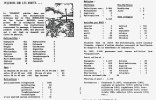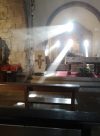JustJack
Active Member
- Time of past OR future Camino
- CF: May/June 2023
VDLP: April/May 2024
As I walked the Via de la Plata from Seville this spring, I had a lot of time to think. A really big amount of time. One of the things I spent some time thinking about is how the purpose or motivation of pilgrimage to Santiago has changed since it began in the middle ages.
Back in the golden era of the Camino de Santiago in the ninth and tenth century, and in subsequent centuries, people walked to SDC for religious reasons. More specifically, they walked there to atone for past sins, to seek some sort of miracle, to pray for help for themselves for for someone else, etc.
While there are no doubt still some that walk for those reasons today, based on the myriad of camino content available it would seem that most people today walk for very different reasons. Specifically they tend to walk because they are looking for time alone to think. Perhaps to process grief or to contemplate a crossroad in their life. Some simply enjoy the peace and nature, and simplicity of camino life. Many walk because of the people they meet along the way. Indeed this seems to be one of the biggest reasons people are attracted to the camino. Many do it for cultural or slow-tourism reasons. What better way to see such a beautiful country. There are other reasons as well, but the point is that the majority aren't doing it for the reasons it was done historically. All those great qualities we like to focus on today - being present in the moment, letting our minds slow down, enjoying the company of fellow pilgrims - were luxuries the medieval pilgrims didn't have. They were simply trying to get to SDC and the long journey was just something that had to be done to get there. I don't know but I suspect that being present in the moment and having time alone with their thoughts wasn't a thing back then.
Not sure what my point is. Not sure I have one, other than to say I find it interesting that in the hundreds or thousands of hours of camino content I've consumed - videos, podcasts, books, forums - I almost never see discussions about how our motivations today are starkly different from what they were when this whole thing began. At least for most of us. We talk about "the camino" and how people have been walking it for a thousand years, as if they've done it for the same reasons we walk it today.
Back in the golden era of the Camino de Santiago in the ninth and tenth century, and in subsequent centuries, people walked to SDC for religious reasons. More specifically, they walked there to atone for past sins, to seek some sort of miracle, to pray for help for themselves for for someone else, etc.
While there are no doubt still some that walk for those reasons today, based on the myriad of camino content available it would seem that most people today walk for very different reasons. Specifically they tend to walk because they are looking for time alone to think. Perhaps to process grief or to contemplate a crossroad in their life. Some simply enjoy the peace and nature, and simplicity of camino life. Many walk because of the people they meet along the way. Indeed this seems to be one of the biggest reasons people are attracted to the camino. Many do it for cultural or slow-tourism reasons. What better way to see such a beautiful country. There are other reasons as well, but the point is that the majority aren't doing it for the reasons it was done historically. All those great qualities we like to focus on today - being present in the moment, letting our minds slow down, enjoying the company of fellow pilgrims - were luxuries the medieval pilgrims didn't have. They were simply trying to get to SDC and the long journey was just something that had to be done to get there. I don't know but I suspect that being present in the moment and having time alone with their thoughts wasn't a thing back then.
Not sure what my point is. Not sure I have one, other than to say I find it interesting that in the hundreds or thousands of hours of camino content I've consumed - videos, podcasts, books, forums - I almost never see discussions about how our motivations today are starkly different from what they were when this whole thing began. At least for most of us. We talk about "the camino" and how people have been walking it for a thousand years, as if they've done it for the same reasons we walk it today.
Last edited:
























